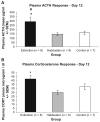Non-associative defensive responses of rats to ferret odor
- PMID: 16183085
- PMCID: PMC2409187
- DOI: 10.1016/j.physbeh.2005.08.044
Non-associative defensive responses of rats to ferret odor
Abstract
Predators and their odors offer an ethologically valid model to study learning processes. The present series of experiments assessed the ability of ferret odor to serve as an unconditioned stimulus and examined behavioral and endocrine changes in male Sprague-Dawley rats with single or repeated exposures in a defensive withdrawal paradigm or in their home cages. Rats exposed to ferret odor avoided the ferret odor stimulus more, exhibited greater risk assessment and displayed higher adrenocorticotropin hormone (ACTH) and corticosterone release compared with control odor exposed rats and these measures did not significantly habituate over repeated exposures. Ferret odor exposure did not show associative conditioning effects during extinction trials. However, rats that were pre-exposed to ferret odor only once, as compared to control and repeatedly exposed rats, displayed a sensitized ACTH and corticosterone response to an additional ferret odor exposure in small cages. These experiments suggest that ferret odor is a highly potent unconditioned stimulus that has long lasting effects on behavior and endocrine responses, and further suggests the independence of habituation and sensitization processes.
Figures




Similar articles
-
Disruption of neuroendocrine stress responses to acute ferret odor by medial, but not central amygdala lesions in rats.Brain Res. 2009 Sep 8;1288:79-87. doi: 10.1016/j.brainres.2009.07.011. Epub 2009 Jul 15. Brain Res. 2009. PMID: 19615352 Free PMC article.
-
Ferret odor as a processive stress model in rats: neurochemical, behavioral, and endocrine evidence.Behav Neurosci. 2005 Feb;119(1):280-92. doi: 10.1037/0735-7044.119.1.280. Behav Neurosci. 2005. PMID: 15727532 Free PMC article.
-
Accessory and main olfactory systems influences on predator odor-induced behavioral and endocrine stress responses in rats.Behav Brain Res. 2010 Feb 11;207(1):70-7. doi: 10.1016/j.bbr.2009.09.038. Epub 2009 Oct 1. Behav Brain Res. 2010. PMID: 19800371 Free PMC article.
-
Predator odor avoidance as a rodent model of anxiety: learning-mediated consequences beyond the initial exposure.Neurobiol Learn Mem. 2010 Nov;94(4):435-45. doi: 10.1016/j.nlm.2010.09.009. Epub 2010 Sep 25. Neurobiol Learn Mem. 2010. PMID: 20884366 Review.
-
Predator odor fear conditioning: current perspectives and new directions.Neurosci Biobehav Rev. 2008 Sep;32(7):1218-27. doi: 10.1016/j.neubiorev.2008.06.001. Epub 2008 Jun 5. Neurosci Biobehav Rev. 2008. PMID: 18577397 Free PMC article. Review.
Cited by
-
The smell of fear: innate threat of 2,5-dihydro-2,4,5-trimethylthiazoline, a single molecule component of a predator odor.Front Neurosci. 2015 Aug 25;9:292. doi: 10.3389/fnins.2015.00292. eCollection 2015. Front Neurosci. 2015. PMID: 26379483 Free PMC article. Review.
-
Reduced contextually induced muscle thermogenesis in rats with calorie restriction and lower aerobic fitness but not monogenic obesity.Temperature (Austin). 2023 Feb 6;10(3):379-393. doi: 10.1080/23328940.2023.2171669. eCollection 2023. Temperature (Austin). 2023. PMID: 37554387 Free PMC article.
-
Anxiety-related behavioral inhibition in rats: a model to examine mechanisms underlying the risk to develop stress-related psychopathology.Genes Brain Behav. 2010 Nov;9(8):974-84. doi: 10.1111/j.1601-183X.2010.00636.x. Genes Brain Behav. 2010. PMID: 20738409 Free PMC article.
-
Repeated ferret odor exposure induces different temporal patterns of same-stressor habituation and novel-stressor sensitization in both hypothalamic-pituitary-adrenal axis activity and forebrain c-fos expression in the rat.Endocrinology. 2009 Feb;150(2):749-61. doi: 10.1210/en.2008-0958. Epub 2008 Oct 9. Endocrinology. 2009. PMID: 18845631 Free PMC article.
-
Predator threat induces behavioral inhibition, pituitary-adrenal activation and changes in amygdala CRF-binding protein gene expression.Psychoneuroendocrinology. 2007 Jan;32(1):44-55. doi: 10.1016/j.psyneuen.2006.10.002. Epub 2006 Nov 20. Psychoneuroendocrinology. 2007. PMID: 17116372 Free PMC article.
References
-
- Anisman H, Lu ZW, Song C, Kent P, McIntyre DC, Merali Z. Influence of psychogenic and neurogenic stressors on endocrine and immune activity: differential effects in fast and slow seizing rat strains. Brain Behav Immun. 1997;11(1):63–74. - PubMed
-
- Blanchard RJ, Nikulina JN, Sakai RR, McKittrick C, McEwen B, Blanchard DC. Behavioral and endocrine change following chronic predatory stress. Physiol Behav. 1998;63(4):561–9. - PubMed
-
- File SE, Zangrossi H, Jr, Sanders FL, Mabbutt PS. Dissociation between behavioral and corticosterone responses on repeated exposures to cat odor. Physiol Behav. 1993;54(6):1109–11. - PubMed
-
- McIntyre DC, Kent P, Hayley S, Merali Z, Anisman H. Influence of psychogenic and neurogenic stressors on neuroendocrine and central monoamine activity in fast and slow kindling rats. Brain Res. 1999;840(1–2):65–74. - PubMed
Publication types
MeSH terms
Substances
Grants and funding
LinkOut - more resources
Full Text Sources
Medical

